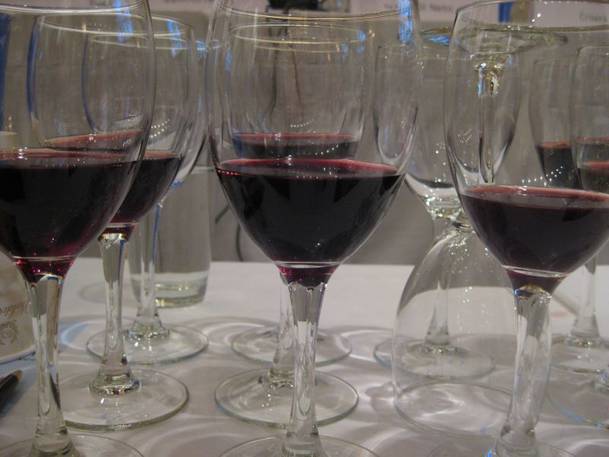


Vino 2010, also known as Italian Wine Week, took place from February 3 to 6. A series of tastings and seminars, dinners and exhibits, it was the largest Italian wine event ever held outside of Italy. I enjoyed the chance to sample the wines, meet the producers, and listen to the discussions, but the most interesting presentation as far as I am concerned was entitled “Italian-American Food...Why Don’t it get NO [sic] Respect?” In 3 days of sessions, it was the only one that focussed on food.
The host of the panel was David Rosengarten, who began with a brief video of a new, and with any luck imaginary, show called “Hava Lasagna” (as in hava nagila, the Israeli folk song). In the video, David visits Italian-American restaurants and grocers seeking to find the flavors he remembers from his early years growing up in Brooklyn. He finally finds it at a restaurant in Queens where he is served a dish consisting of alternating layers of breaded and fried veal and eggplant cutlets, tomato sauce and melted mozzarella. In his opening remarks, Rosengarten speculated on whether food such as this, his Italian Anerican ideal, represents a unique, regional cuisine and why it has never been highly regarded, except by aficionados such as him.
What Rosengarten didn’t seem to realize is that the food he calls Italian-American as embodied in that veal dish, is not necessarily what an Italian-American would think of as typical. To me, an Italian American, who also grew up in Brooklyn, that sort of dish was a cartoonish version of Italian American food. We never ate that way at home, nor did any other Italian Americans that I know. My mother, a skilled cook, when asked which Italian restaurant she liked best, would always say she preferred to eat at home because Italian food in restaurants was not very good. David’s veal dish was the kind of thing she referred to. It was far too rich, too greasy, and too heavy to be genuine Italian American food. It was restaurant food, made up by Italian immigrants and others to entice a non-Italian clientele.
The other panelists included Tony May, legendary New York restaurateur and owner of SD26, who spoke about his experiences in the restaurant industry and stated that the insistence on any “regional” identity keeps Italian cuisine at the level of simple trattoria food. Instead, May believes, we should identify food as being Italian and not regional. Tony emphasized that Italian cuisine is a “cuisine of ingredients”, relying in large part for its quality on the use of ingredients imported from Italy. Without these ingredients, he said, the food cannot be Italian.
Piero Selvaggio, the owner of Valentino Restaurants in Santa Monica and Las Vegas, as well as several others, told us how, as a young man, he was exposed to fine Italian cooking on a visit to Italy and from that point steered his restaurants away from Italian American food. He strives to prepare food as it is done in Italy, and seeks to find the best imported foods. He is, however, open to blending Italian and non-Italian foods, as in his new Houston restaurant where much of the menu is a hybrid of Italian and Mexican flavors.
Lou Di Palo of DiPalo Fine Foods spoke about his family’s long involvement in the food business. He recalled how his grandmother would make meatballs out of scraps of cheap meat scraps or cuts that were past their prime because that was all that the family could afford. Having experienced extreme poverty, they were all the more appreciative of the bounty of food they found in this country. He takes great pride in the high quality Italian products he imports and sells.
Ric Torrisi and Mario Carbone are the co-owners of the ironically named Torrisi Italian Specialties, a new shop in downtown Manhattan specializing in non-Italian products. The two young chefs believe in supporting only domestically produced products, even if it means shunning incomparably better, and often less expensive imports like Parmigiano-Reggiano, Prosciutto di Parma or San Daniele, or San Marzano tomatoes.
Michael Batterberry, editor and founder of Food Arts and Food & Wine magazines, also spoke. His take was that the best way for a restaurant to identify itself with regional Italian fare is as “special” items on an otherwise generic Italian menu, since many Americans still shy away from ingredients like rabbit, or tripe.
I hope that the Italian Trade Commission and Vino 2011 will host more dialogues such as this one. The conversation was stimulating and enjoyable even though none of the speakers or the audience members really responded to the question that Rosengarten raised. I guess they just didn’t give it NO respect.
Source URL: http://ftp.iitaly.org/magazine/article/italian-american-food-why-dont-it-get-no-respect
Links
[1] http://ftp.iitaly.org/files/13125img09161265742659jpg